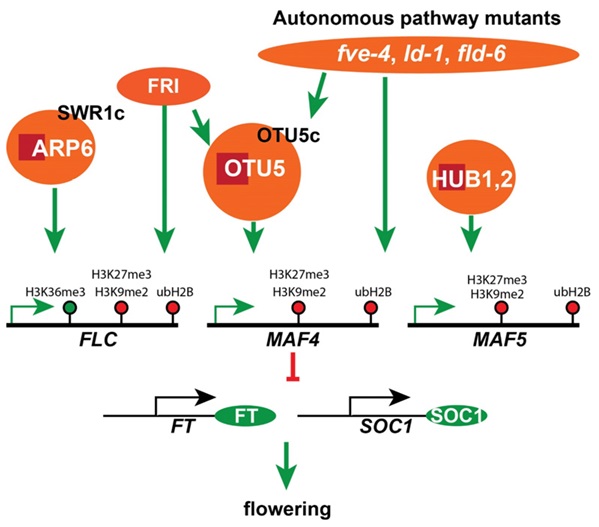
We find ourselves in the marvelous world of nature, where each season bestows upon the natural canvas a unique and magical spectacle. Among them, spring stands out as perhaps the most enchanting period. As the earth adorns itself in a lush green mantle and flowers burst into a vibrant symphony, the colorful floral tapestry breathes a refreshing new life into our surroundings. However, have you ever wondered why spring is always filled with a profusion of blossoms? Why do certain plants flourish swiftly during the suitable season while others appear to linger in stillness? Behind these ordinary occurrences lies nature’s most precious and magical gift to us.
The growth and flowering times of plants are intricately connected to ecosystems, directly influencing the survival of other organisms. Consider this: if flowers were to bloom at the wrong time in spring, bees and butterflies would struggle to find enough nectar, potentially jeopardizing their survival. Similarly, the timing of fruit ripening in certain plants influences the migration and reproduction of birds and mammals. This close interdependence underscores the importance of studying plant growth and flowering. Understanding how plants regulate their life cycles to adapt to changes in the external environment not only contributes to the better protection of ecosystems but also enhances the efficiency of agricultural production and food supply. Among the various factors influencing flowering time, a protein known as OTU5 plays a pivotal role. OTU5 serves as a crucial “flowering time regulator” in the plant kingdom, impacting not only plant growth but also the overall functioning of ecosystems.
The regulation of plant growth and flowering is an exceedingly complex and delicate process, involving multiple biological mechanisms. Before delving deeper into the discussion, it is essential to gain a further understanding of the processes of ubiquitination and deubiquitination, two independent but reversible mechanisms critical for modulating important cellular regulators.
🌷 Ubiquitination and Deubiquitination
Ubiquitination is the process of marking proteins, typically to specify them for degradation or other intracellular activities, signaling to the cell that this molecule needs specific handling. In this process, a small protein called “ubiquitin” is covalently attached to the target protein, much like affixing a label. This label usually informs the cell that the target protein needs to be degraded or participate in specific intracellular activities. Ubiquitination is a highly intricate system within the cell, contributing to the regulation of protein quantity and quality, regulating the cell cycle, and participating in crucial activities such as immune responses and DNA repair.
In contrast to ubiquitination, deubiquitination is the process of removing ubiquitin, much like peeling off a previously attached label. Deubiquitination is executed by specific proteins known as deubiquitylation enzymes (DUBs). These enzymes can recognize and remove attached ubiquitin labels. The significance of this process is equally crucial, as it allows proteins to regain their normal function without being influenced by ubiquitin tags. Deubiquitination ensures that proteins can perform their biological functions when needed, ensuring the normal operation of the cell.
The balance between ubiquitination and deubiquitination is crucial for maintaining cellular health and survival. Excessive ubiquitination may lead to the degradation of too many proteins, impairing normal biological functions, while excessive deubiquitination may result in the unnecessary accumulation of proteins, also adversely affecting the cell.
🌷 What is OTU5?
OTU5 is a member of one of seven DUB families, the OTU family, as it harbors a conserved OTU deubiquitination domain. This implies that OTU5 is responsible for removing ubiquitin marks from proteins, thereby influencing the biological processes in which these proteins are involved. Mutant analysis indicates that OTU5 is involved in numerous plant functions and the primary function of OTU5 is to suppress flowering by activating expression of major flowering suppressors. Hence, it can be referred to as a “flowering time regulator” or, more metaphorically, a “seasonal manager” within the intricate mechanisms of plant biology.
🌷 The latest research findings from the Institute of Plant and Microbial Biology, Academia Sinica, revealed that OTU5 is a novel flowering suppressor, participating in the epigenetic regulation of genes associated with flowering time.
Previous studies have indicated that numerous pathways mediate the inhibition of flowering in Arabidopsis including SWR1c- and HUB1/2-UBC1/2-mediated. The SWR1c pathway initiates the deposition of H2A.Z to activate flowering inhibitory genes related to FLC, while the HUB1/2-UBC1/2 pathway modulates genome-wide ubH2B levels and activates a distinct set of FLC-related repressors through distinct activating/repressive histone marks.
The research team, led by Dr. Hongyong Fu and Dr. Wolfgang Schmidt at the Institute of Plant and Microbial Biology, recently discovered a novel flowering suppressor—OTU5. This regulator plays a pivotal role in the intricate regulation of plant growth and flowering. Once OTU5 undergoes mutations, impairing its function (as observed in the otu5-1 mutant), various changes occur in plants, including early flowering. To delve deeper into the factors with altered OTU5 function, the team conducted transcriptome and RT-qPCR analyses. The results revealed a primary cause of early flowering in otu5-1: a decrease in the expression of major flowering suppressors such as FLC, MAF4, and MAF5.
To further explore the mechanisms by which OTU5 participates in the epigenetic regulation of FLC, MAF4, and MAF5 genes, the research team utilized Quantitative Chromatin Immunoprecipitation (qChIP) technology to assess changes in the levels of activating and repressive histone marks at FLC, MAF4, and MAF5 loci in otu5-1 plants. They not only investigated histone marks related to activation of FLC and MAF4-5 and flowering inhibition but also checked dynamic changes in histone mark levels in otu5-1 plants. The study revealed a widespread reduction in the activating histone mark H3K36me3 across all tested regions of FLC and MAF4-5 in otu5-1. Conversely, suppressive histone marks H3K27me3 and H3K9me2 exhibited a general increase in all tested regions of FLC and MAF4-5 in otu5-1. Furthermore, ubH2B levels showed a consistent upward trend across all tested regions of FLC and MAF4-5 in otu5-1 plants. These significant findings contribute to a better understanding of how OTU5, through chromatin modification, activates FLC and MAF4-5, thereby delaying the flowering time in plants.

Arabidopsis OTU5 regulates flowering by modifying histone marks to enhance the expression of key flowering suppressors FLC, MAF4, and MAF5.
OTU5 acts in parallel with SWR1c- and HUB1/2-mediated pathways. OTU5 primarily activates genes such as FLC, MAF5, and MAF4, which, in turn, further inhibit major flowering initiators FT and SOC1 to suppress flowering.
After unraveling the enigmatic secrets of OTU5, we uncovered its role as a guardian in the plant kingdom, playing an indispensable role in the growth and blossoming of plants. OTU5, in its unique way, contributes to histone modification, profoundly shaping the plant ecosystem. It not only steers plant genes crucially but also takes center stage in flowering regulation with its unique mechanism. Compared to other histone modification pathways, OTU5 highlights its uniqueness, providing diverse regulatory pathways for plant growth and paving the way for new directions in future research on plant ecology and agriculture. The discovery of OTU5 not only expands our understanding of plant growth and flowering regulation but also unlocks nature’s mysteries, fostering a deeper comprehension of plant ecosystems.
【Suggested Reference】
Ramalingam Radjacommare, Shih-Yun Lin, Raju Usharani, Wen-Dar Lin, Guang-Yuh Jauh, Wolfgang Schmidt* and Hongyong Fu*
The Arabidopsis Deubiquitylase OTU5 Suppresses Flowering by Histone Modification-Mediated Activation of the Major Flowering Repressors FLC, MAF4, and MAF5
Int J Mol Sci 24 (7), 6176, 2023-03-24
https://www.mdpi.com/1422-0067/24/7/6176
